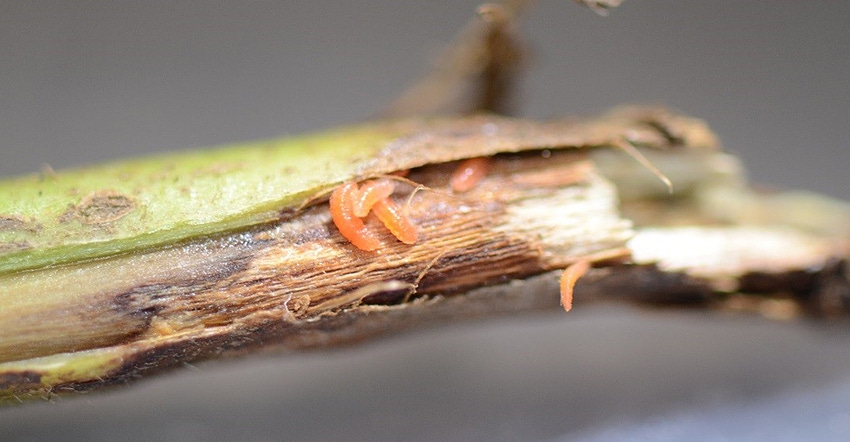
University of Minnesota Extension specialists reported in late August that they have received a few reports about a new pest infesting soybeans in Minnesota fields.
Bruce Potter, Extension Integrated Pest Management specialist in Lamberton, and Bob Koch, Extension entomologist in St. Paul, wrote in a recent blog about the orange gall midge reportedly causing injury to soybeans in McLeod and Rock counties, Minn. The midge has been identified in soybean fields in parts of the Midwest this summer.
“We really don’t know much about this species yet,” Potter says. “From what I can tell, the Rock County infestations are different than most of the reports this year that seem to be associated with stem disease — white mold in particular.”
Samples from the Rock County soybean field had stems infested with small, pale to bright orange gall midge. These larvae matched the description of the insects causing the concern in western Iowa, eastern Nebraska and southeast South Dakota. Symptoms included plants brittle near the base, dark lesions on the stem, hollowed pith, larvae under the stem epidermis, and ultimately plant death.
The Extension specialists noted that in previous years, midge infestations were associated with injury from hail and disease. However, the relationship of recent infestations to previous stem injury has been less clear, and this includes the Rock County infestation. They wonder if the insects can infest plants directly.
Potter also visited a McLeod County soybean field with a crop consultant. They found small, orange maggots associated with sclerotinia white mold, predominately in the pith.
Based on the appearance of the damage and the larvae, the Extension specialists say they may not be the same species. Samples of larvae from these two fields were collected for future comparisons with specimens from the infested Iowa, South Dakota and Nebraska fields.
A seed company agronomist reported small infestations from Ottertail, Wadena and Stearns counties, Minn., and Extension received a report from Olmstead County, Minn. Some of these infestations were associated with diseased stems.
As of late August, it did not appear that Minnesota was having the same level of problems as neighboring states, Potter adds.
To learn more about the pest, Potter offered this link to a recent Nebraska publication about orange gall midge in Nebraska.
Read the Extension blog post about soybean/orange gall midge.
And if you notice soybeans with symptoms and maggots resembling the gall midge, please contact either Potter ([email protected]) or Koch ([email protected]).
About the Author(s)
You May Also Like






